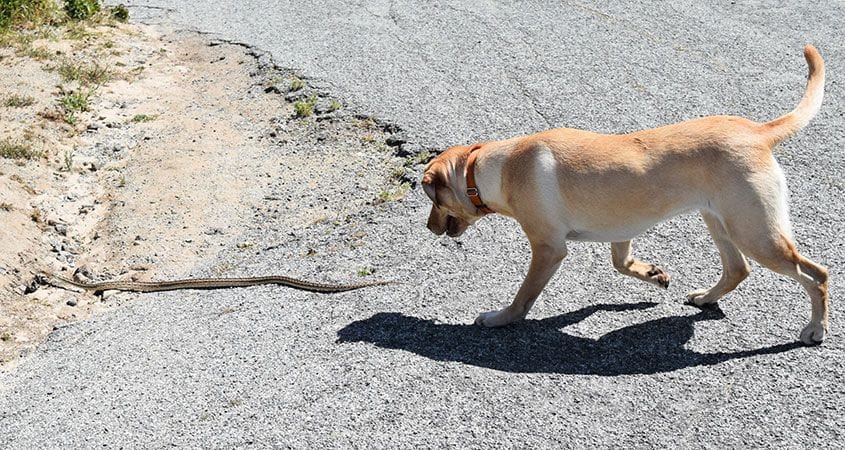There are many different venomous snakes. Know the kinds of snakes you have in your area and what the dangerous ones look like. It’s not always easy to tell what kind of snake bit your dog, but if you do know, it can help your veterinarian determine the best treatment.
In North America, there are four principal kinds of venomous snakes: rattlesnakes, cottonmouths (aka water moccasins), copperheads, and coral snakes.
Snakes You May Encounter in North America
Rattlesnakes
Rattlesnakes live in a variety of habitats. They can be found in deserts, forests, and wetlands, from sea level to mountain elevations. Rattlesnakes are most active in warmer seasons, from spring to autumn. In some areas they can be found year-round, particularly in southern latitudes.
Cottonmouths
While generally active at night, will bask in the sun by day in order to keep their metabolism up, since they are cold-blooded. Frequently found around water, they are not aggressive but will attack if threatened or agitated. They can be found mostly in the southeastern U.S.
Copperheads
There are five sub-species of copperheads, scattered through the southern two thirds of the eastern U.S. While its venom is the least potent of the North American snakes, it also accounts for the most human snakebites. This is probably partly due to the snake being well-camouflaged in its environment so that people — and dogs — don’t see it until they’re right on top of it.
Corak Snakes
Coral snakes are among the most venomous. While their bite seems to have no immediate effect, their powerful neurotoxins will begin to destroy connections between the brain and muscles if not treated within 12 hours. This snake is probably best known for the warning rhyme that distinguishes it from similar looking species, like the scarlet kingsnake: “Red meet yellow, kills a fellow; red meet black, friend of Jack.” Fun fact: coral snakes actually “fart” defensively by forcefully expelling air from their cloacae, which makes a loud popping sound designed to scare away predators.
Risks and Misconceptions
Since dogs are natural explorers, they are at risk for snakebite whenever you’re in a snake’s habitat. Curiosity or a prey drive can place your dog at risk, but like people, dogs can stumble over the location of a snake by accident, such as when running through a field of high grass, or chasing a completely unrelated scent.
There are a lot of misconceptions about snakes, how dangerous they are, and when they’ll bite. Here’s the truth about a few of those myths.
A snake’s head size doesn’t indicate how dangerous they are
Adult male brown water snakes have fat heads and they are non-venomous. Many non-venomous snakes flatten their heads when stressed and appear to have viper-like heads. Coral snakes are highly venomous and have skinny heads.
A snakebite can be serious
Even if your dog survives the immediate effects of a bite, it has the potential to cause permanent injury. The toxic components of snake venom are very painful and can have severe consequences. Although there are three main varieties of venom, there can be some overlap of effects within a single species. The types of venom and their targets are cytotoxins, which destroy cells, particularly muscle cells; neurotoxins, which destroy nerves and connections in the nervous system; and hemotoxins, which destroy the blood, particularly red blood cells, depriving the victim of oxygen.
A snake won’t necessarily give you warning before they strike
Sometimes rattlesnakes rattle before they strike, but don’t count on it. A snake’s best defense in the wild is its camouflage. A snake’s first reaction is usually to lie perfectly still and hope that it goes unnoticed. While snakes may be reluctant to confront humans and large dogs, smaller dogs may be in greater danger of being perceived as prey and attacked by a snake.
A baby snake is just as venomous as an adult snake
And they could be more dangerous as well. Baby snakes typically aren’t developed enough to be able to control the amount of venom that they distribute. In a single bite, a baby snake may dispense all of its venom, where as an adult snake is able to size up its prey and will dispense only what is needed for the job. It will not dispense all of its venom to ensure that it is still able to defend itself if necessary.
A snakebite is always an emergency
If your dog is bitten, take her to a veterinarian for treatment immediately. Even bites by non-venomous snakes can lead to serious infections because of bacteria in their mouths, which may require treatment with antibiotics.
Treatment or Prevention
Snakebite treatment can be expensive. Antivenom injections (also called antivenin) can cost hundreds to thousands of dollars each and your dog may require multiple shots, along with hospitalization, IV fluids, and other medications. The injections may also cause side effects that complicate recovery.
Dogs are somewhat luckier than humans in that canine antivenom is cheaper — the human equivalent can cost tens to hundreds of thousands of dollars a shot, although only 0.1% of this cost is a result of actually making the vaccine. The rest is due to licensing, regulation, clinical trials, and hospital mark-ups.
According to some veterinarians, antivenom may not always be necessary; for example, medium to large size hunting dogs bitten in the face may not need it. But the circumstances when you will always need antivenom are as follows:
- Dogs under 20 pounds bitten by a rattlesnake or cottonmouth.
- Dogs bitten multiple times or on the tongue or torso, regardless type of snake.
- All dogs bitten by coral snakes, although supplies of coral snake antivenom are extremely limited and may not be immediately available.
- All dogs bitten by very large snakes, particularly rattlesnakes.
- All dogs bitten by dying snakes of any kind. Remember, adult snakes can control how much venom they inject, but a dying or severely injured snake will generally let loose with all of it.
Rattlesnake vaccines are available for dogs (but not humans), although there is still a lot of disagreement on whether they are effective or necessary. They confer about a year’s immunity and require annual boosters. While they may be advisable if you’re in an area with a lot of snakes, the vaccine will only work for the specific type of snake it was derived from. And, even though it provides some protection, a vaccinated dog that is bitten will still require immediate medical treatment.
The Best Protection
Needless to say, the best way to keep your dog safe from snakes is to be aware of your surroundings. If you’re going hiking, learn what kind of snakes are common in the area and what times of year they’re most active.
Avoid places snakes are likely to be hanging out, like in the bushes just off of trails or in culverts or tall grass. Also remember that snakes can find their way up trees, so watch out for threats at eye level as well. Most snakes are nocturnal, so be particularly careful about securing things if you’re going to be camping out overnight, and make your dog stay in the tent with you — sleeping rough without a tent is never a good idea in snake country. You never know what you’ll wake up with in your sleeping bag.
Finally, you can always invest in putting your dog through some snake aversion training, which will make her as wary of the slithering serpents as you are. And, since your dog will be able to smell a snake long before you can see it, this kind of training will provide extra protection for both of you.
What wild animals represent a threat to dogs in your area? Tells us in the comments.











